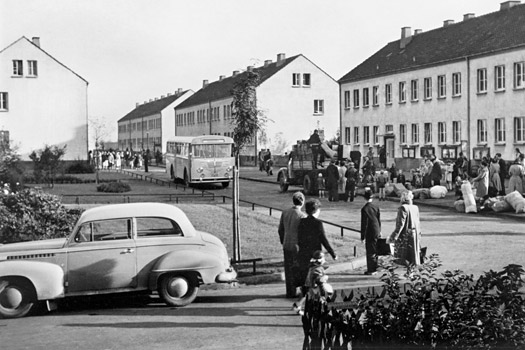
Aufnahmestelle für Aussiedler, Zuwanderer und ausländische Flüchtlinge in Unna-Massen
Über 50 Jahre wurden in der Aufnahmestelle in Unna-Massen Aussiedler, Zuwanderer und ausländische Flüchtlinge vorbereitet auf ihr neues Leben in Nordrhein-Westfalen.
© Archiv Landesstelle Unna-Massen/Bezirksregierung Arnsberg, Dezernat 36 - Kompetenzzentrum für Integration
Leute zurück zur Auswahl
Unna-Massen State Office
Seismograf der Weltpolitik
Initial accommodation of immigrants and foreign refugees
“Teute” – old German for border (“Grenze”) – is the field name of the tract of land in Massen upon which numerous white plastered houses were constructed as standard public housing in 1951. With 1,500 spots the camp served as a transition facility for refugees and immigrants who were given “initial accomodation”, and prepared for their new life in North Rhine-Westphalia.
After 1945, the transit camp was initially located in Siegen in the barracks on Wellersberg, a dismal makeshift camp of the immediate post-war period, through which the transports of displaced persons from Silesia were channelled. For this reason the mayor of Massen had to reassure the community that “this will not become a slum” when a receiving center with a kindergarten, school, sports fields, and hospital ward were developed directly across from the “Korsika” mining settlement.
The use of the buildings as refugee residences was not what was intended for this transit area. “In two to three years this facility will be unnecessary“, surmised the camp director, Alfred Becker, in 1951. Then miners should move in. However, immigration, particularly from the GDR, did not let up. In 1955 the last German soldier prisoner’s of war were released from the Soviet Union. Emigrants from Poland, Hungary, Romania, Yugoslavia, and Czechoslovakia (CSSR) found initial accommodations here. The number of people of German descent from the communist countries, who were able to leave the country remained dependent on contracts between the Federal Republic and the East European governments. Only Gorbachev’s reform policy at the end of the 1980s enabled ethnic Germans living in Russia to leave the country unhindered.
When the African dictator Idi Amin, in a despotic act, drove inhabitants of Indian descent out of Uganda in 1972, 26 of them found temporary care in the state office. Chilean refugees, “Boat People” from Cambodia and Vietnam, refugees of the conflicts in the former Yugoslavia, Unna-Massen became a “seismograph” of the refugee movements in the World. The state office has temporarily cared for 2.5 million people from over one hundred countries.
Until its closure in June 2009, only a few ethnic German immigrants (late repatriates) from the former Soviet Union and Jewish immigrants lived in the state office housing. The human trains that were a direct, or indirect, result of the Second World War came to an end: displaced persons have long since been integrated into North Rhine-Westphalia, the Federal Republic is reunified, a large percentage of people of German descent from Eastern Europe and Russia have returned to their “original homeland” of Germany since the fall of the “Iron Curtain”. More than a few ethnic German immigrants (late repatriates) return to Kazakhstan, or elsewhere, in 2009 because they did not feel at home in the Federal Republic.
Denkmale zum Impuls
Unna - Aufnahmestelle für Aussiedler, Zuwanderer und ausländische Flüchtlinge in Nordrheinwestfalen
In der Nähe des Ortes Massen bei Unna entstand 1951 eine Aufnahmeeinrichtung für ... weiter
